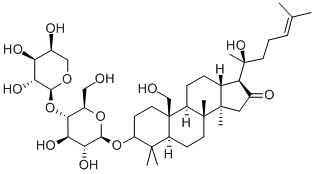Many pre-clinical studies demonstrated the efficacy of Bacopa Monnieri (BM) in protection of neuronal cells from various types of damage (particularly oxidative damage) through a series of different mechanisms.
Introduction
Bacopa Monnieri is a perennial plant with small oblong leaves and violet flowers, part of the family plantaginacee. It typically grows in wetlands of southern India and Australia.
It is used in Ayurvedic medicine to improve cognitive function, but it's currently being studied (for its neuroprotective properties) in treatment for epilepsy, dementia, Parkinson's disease and other neurodegenerative disorders (Alzheimer's disease).
Active constituents
- Bacosides: dammarane-type triterpenoid saponins, with jujubogenin or pseudo-jujubogenin moieties as aglycone units. Bacosides comprise a family of 12 known analogs and they are the most represented (bacoside A) in BM extract.
- Bacoposides (I-XII): saponins more recently identificated
- Other less represented constituents: brahmine, nicotine, herpestine, D-mannitol, apigenin, hersaponin, monnierasides (I–III), cucurbitacin and plantainoside B
 Bacoside A
Bacoside A
Neuroprotection mechanisms
BM performs its neuroprotective effect through the following mechanisms:
1. Anti-oxidant effect (via redox and enzyme induction)
2. Reduced storage of protein β-amyloid and α-synuclein
3. Modulation of certain neurotransmitters (acetylcholine, serotonin and dopamine)
4. Increased cerebral blood flow
Anti-oxidant effect
The brain is particularly susceptible to oxidative stress because it's metabolically active, has high levels of pro-oxidant iron and is composed of unsaturated lipids (subjected to lipid peroxidation). In addition, the blood-brain barrier (BBB) prevents many exogenous antioxidant factors from reaching the brain.
Administration of bacoside A (in murine models exposed to cigarette smoke) prevents oxidative damage leading to a significant increase in the cerebral concentration of vitamins A, C and E.
Offshoots of BM also imply an increase of glutathione through the up-regulation of glutathione reductase (GSR) and glutathione peroxidase (GPx). Also catalase and super oxide dismutase (SOD) increase their activity; this is due to the highest levels of local cofactors zinc and selenium (effect mediated BM).
Lipid peroxidation is also reduced, resulting in the preservation of mitochondrial membrane (and its potential) and of the activity of mitochondrial complex I(ubiquinone).
Oral bacosides's administration has protective effect against age-related chronic neuroinflammation: in murine mice undergoing long-term treatment with bacosides were identified concentrations significantly reduced of proinflammatory cytokines (IL-1β and TNF-α but not of the INF-γ), lipofuscin and total nitrate and up-regulation of inducible NO synthase (iNOS).
Reduced storage of protein β-amyloid and α-synuclein
In vitro studies have demonstrated the ability of BM's extract to prevent aggregation of β-amyloid protein's deposits and determine the dissociation of preformed fibrils. However, it is unclear if this activity is carried out in vivo.
BM in nematodes also allowed a statistically significant reduction of α-synuclein aggregation. This is probably due to the induction of heat shock protein (Hsp) 70: ATPase involved in the mechanisms of cellular defense against oxidative stress and heat.
Modulation of certain neurotransmitters
Administration of BM's extract restores the availability's deficit of acetylcholine (ACh) in brains of old mice, leading them to values similar to younger ones. The hypothesis is that the primary ACh-boosting mechanism of BM is not acetylcholinesterase (AChE) inhibition but choline acetyltransferase (ChAT) activation (synthesis of ACh).
Also the activity of GPx and livels of serotonin and dopamine and are higher than normal (antidepressive effect).

Increased cerebral blood flow
The administration of BM extract was effective in increasing cerebral vessels's perfusion. The mechanism is based on the release of NO from endothelial cells and in the block of calcium's fluctuations between the inner and outer side of sarcoplasmic reticulum's membrane. This promotes cerebral vasodilation without alteration of blood pressure.
Other neuroprotective mechanism resides in activation of phosphokinase C (PKC)'s and phosphoinositide-3 kinase (PI3K)'s and Akt's pathways by bacopasidi (particularly bacopaside I). These pathways are very important in neuronal cells's survival and differentiation. An increase in the brain content of ATP, NO and the activity of the Na + / K + ATPase and C was also shown.

Other effects
Bacosides have a role in gene expression, resulting in activation of the transcription factor CREB. This factor is involved in the transcription of several neuropeptides (such as somatostatin, enkephalin, VGF, ...) directly involved in the modulation of synaptic plasticity and able to increase memory in healthy subjects.
Toxicity
Adverse effects due to BM were rarely reported in humans. Common symptoms are nausea and an increased bowel motility but there're no studies on long-term toxicity.
A reduction in motility and number as well as an altered form of spermatozoa present in seminiferous tubules and epididymis were found in male mice.
Conclusions
BM has shown great potential in improvement of age-related cognitive disorders and neuronal degeneration. Its numerous effects: anti-inflammatory, antioxidant, cerebral vasodilator and protection from ischemic injury, as well as neurotransmitters's levels restoration (such as acetylcholine, serotonin and dopamine) and block of aggregation and deposition of β-amyloid protein and α-synuclein, make it potentially useful in prevention and treatment of neurodegenerative disorders such as Alzheimer's disease (and SDAT) and Parkinson's disease.
In healthy subjects BM allows an improvement in learning ability and memory through modulatory action on synaptic plasticity.
Biomedical research on BM is still in its preliminary stage, so that the effects of bacosides are often studied on samples in vitro and in animal models; there are few studies on humans. Nowdays there are still no long-term studies of BM in combination with other substances (as prescribed by Ayurvedic medicine), able to work synergistically.
References